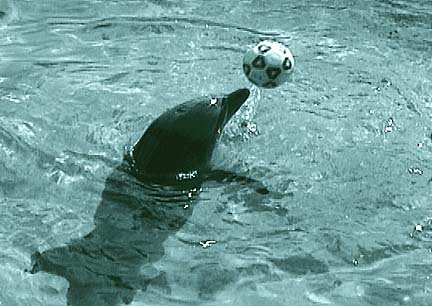


Kewalo dolphin Scientists at the Kewalo Basin Marine Mammal Laboratory are mourning the death of a bottlenosed dolphin that taught them much about dolphin intelligence, behavior, communication and sensory abilities.
dies of infection
Scientists say Elele taught
them much about dolphin
abilities and intelligenceBy Helen Altonn
Star-BulletinElele, one of four dolphins at the research facility, died Dec. 16 after an acute abdominal infection, Dr. Louis Herman, laboratory director and president of the Dolphin Institute, said yesterday.
Cathy Goeggel, director of research and investigations for Animal Rights Hawaii, today questioned why the laboratory "kept so quiet" about the death. "What are they hiding?" she asked after she said the laboratory refused her request for the necropsy report.
Goeggel suggested that information about the dolphin's death had been "suppressed by TDI (The Dolphin Institute), perhaps due to the sensitive negotiations they have been engaged in" to transfer the dolphin lab to Maui.
Goeggel said the three remaining dolphins should be returned to the Gulf of Mexico, rehabilitated and released. Until, they should be placed in open ocean pens at Coconut Island, she said.
"That's absolute nonsense," Adam Pack, assistant lab director, said today. "It's no mystery that her agenda is no dolphins being housed and no learning from dolphins about their abilities."
The U.S. Department of Agriculture, which regulates dolphins in captivity, "has consistently given high marks to the dolphin facility at Kewalo Basin," he said.
Pack said state veterinarian Thierry Work conducted the necropsy on Elele and it's available at the National Marine Fisheries Service. Her death was reported immediately to the USDA, the University of Hawaii administration and the UH committee that monitors captive animals, he said.
"Additionally, this was a friend of our family. We have been grieving and mourning her death since, and trying to move forward with our work."
He said samples also were sent to a laboratory for histopathology examination to better understand the cause of Elele's death, determined to be a bacterial infection.
Physical exams were done on the other dolphins, who appear to be in fine health, he said.
Herman said, "Elele was a special member of our laboratory family, and we all feel her loss deeply." He asked that people who met Elele remember "her intelligence, sensitivity and energy, and her willingness to bridge the gap between species through communication."
A paper reporting on her ability to recognize the shapes of objects investigated through ecolocation won an American Psychological Association award for the best paper published in the Journal of Comparative Psychology in 1998.
The scientific journal Animal Learning & Behavior recently accepted an article for publication about Elele's ability to understand references to her body parts.
Researchers taught the dolphin to associate specific gestures with nine of her body parts.
She was able to use them in four different ways in response to the instructions, to either touch or toss an object or simply display or shake the body part.
Herman said Elele died several months after he completed the study with Dave Matus, Elia Herman, Marina Ivancic and Pack.
The staff returned her ashes to the ocean in a ceremony at sunset, he said.